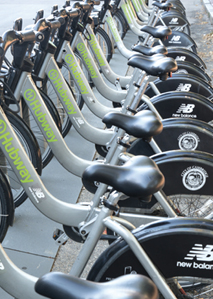
By Shane Farthing
Local government managers are facing a multitude of transportation and land-use decisions with seemingly more uncertainty than has existed in decades. Lack of roadway capacity in major urban area is emerging as a major economic/planning constraint.
Everyone is looking for the next magical solution to this dilemma--a solution that avoids public major transportation projects that will only lead to greater gridlock on the highways.
Much attention is now focusing on operational transportation changes that are finding traction: The rise of such driver services as Uber and Lyft, the functional beginnings of autonomous vehicles, the urban growth in biking and walking, and the urban success of bikesharing, including the dockless option.
In the next 10 years, I believe we'll likely see an even greater magnitude of operational change as autonomous vehicles go from the testing labs to the streets at scale. On-demand delivery, which allows for the true sharing of vehicles, might well replace the owned-vehicle model altogether.
And point-to-point ridesharing will become more widespread. All of which will take place against a backdrop of dwindling funding for transportation generally and transit specifically, and generational changes in preferences for commutes and mobility in general.
Given these emerging trends, how should a responsible local government manager proceed? Here's a basic outline of 10 solutions to making smart transportation and land-use decisions, especially when trying to attract and locate a major organization (i.e., large traffic-driver) in an uncertain transportation landscape:
Protect the place. Transportation serves economic and community development. It is not an end, but a means. Don't degrade what is good about your community in order to move people around it, or you'll soon lose the people you were trying to move.
Protect the people. All the new companies springing up to provide mobility solutions are doing so on public roads. Many of them seek to externalize costs to the public, from the road maintenance costs, to the labor costs of gig-based contractors compared to employees, to the environmental costs of emissions from increased vehicle miles traveled (VMT). Don't subsidize them by accepting those externalities.
Bet on the simple. People will always walk. Make everything you can work for walkability, then expand outward to other transportation modes based on their spatial capacities. Trails, sidewalks, bike infrastructure, and bikeshare have small raw numbers but high-satisfaction rankings and top-rated cost efficiency.
Take proximity seriously. Mixed-use developments allow people to live and work in close proximity. All the possible modes will have different radius limits. The closer things are, the more efficient people and transportation networks become. Each person who walks or bikes to work is generating value in a community, while costing infrastructure far less.
Induce transportation mode shift. Efficiency is your friend. Take a position on which transportation modes are best for long-term economic and community health. Establish a policy to incentivize what is good for a community and to de-incentivize what is not. Nothing is gained from neutrality or inaction.
Realize that safety and stress affect behavior. Today, fewer than 5 percent of people will ride a bike as a primary transportation mode because they fear sharing space with cars. Getting people to bike and walk depends on providing facilities that make them feel safe and protected, which often requires separation from high-speed traffic.
Public transportation should stay a public good. Residents expect to be able to go about their daily business without having to rely on private transportation companies, which might have unknown data and privacy policies and no direct accountability to them.
There is currently a battlefield brimming with companies competing for market share in both trips and data. Most of these companies won't survive with their current business models intact, so localities should resist the temptation to outsource transportation provision to them. It may work in the short-term but will foreclose options long term.
Prepare for change. Invest in smart, flexible transportation commitments that don't lock a community into any one solution or provider. Presently, outside capital is funding a significant portion of every trip from the app-based, ride-hailing giants.
That subsidy makes each trip a bargain for consumers, but that bargain is an unsustainable one. Eventually, the bill will come due. Policy leaders need to engage in long-term planning to ensure that short-term consumer preference doesn't eliminate more sustainable options, which residents will still need when venture capitalists stop paying the bill.
Bet on equitable mobility for all. Betting on any one mobility company can be risky. By emphasizing strong land use controls and infrastructure that serves all neighborhoods and people equitably, a manager can provide the underlying public assets that enable a community to benefit most from transportation services, no matter which company ends up providing them.
Shane Farthing is senior director, Active Transportation Programs, Rails-to-Trails Conservancy, Washington, D.C. (shane@railstotrails.org; www.railstotrails.org).
New, Reduced Membership Dues
A new, reduced dues rate is available for CAOs/ACAOs, along with additional discounts for those in smaller communities, has been implemented. Learn more and be sure to join or renew today!
